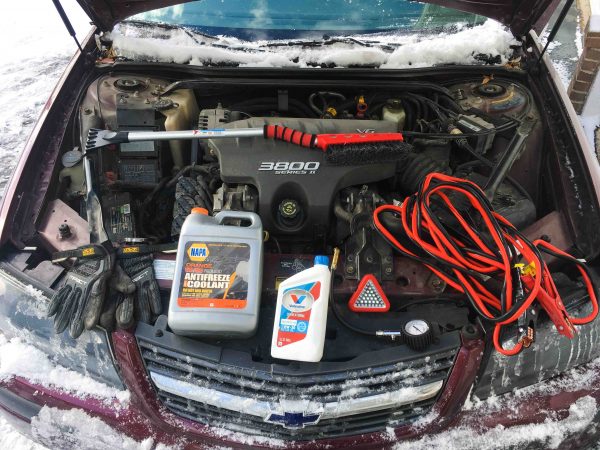
Gloves, antifreeze, a snow/ice remover, hazard lights, pressure guages and jumper cables are some items to help prepare for winter driving. Brian Babcock | Washtenaw Voice
By Brian Babcock
Staff Writer
Dec. 21 is the first day of winter in the Northern Hemisphere and it’s usually best to be prepared for the elements. That includes your vehicle.
Mark McCullough, owner of Mark’s Auto Service in Dexter, offered some tips to help get your car winter-ready.
Don’t ignore that low tire pressure light during the winter
One cause for stuck vehicles are flat tires. Why? Roads hold debris. When snowstorms hit, plows come out, and items that were sitting on the side of the road get churned up and thrown onto the driving path. McCullough’s solution is simple: do not ignore that low tire pressure message or wait until the last minute.
“If you notice your tire light is coming on or you notice a low tire and you’re filling it up [over and over], get it repaired before a snowstorm hits.”
The sensors are in the car for a reason—to let you know that your tires are going flat. If it’s an emergency, fill it up and keep going, but don’t do this over and over.
Make sure you have high-quality winter tires
This may seem obvious, yet dozens of cars will be found in ditches days after a hard snowfall. It costs some money, but buying a quality set of deep-tread winter rubber helps. The narrower the tire and the deeper the tread, the better. McCullough recommends either a winter tire or an all-season tire. Thin, wide, low-profile rubber will only make your driving experience like an ice rink.
When most people measure tread depth, but this can be deceptive, because the first 50% of the tread is all that’s any good, McCullough said.
“Once you wear your tires down to where there’s only 50-30% left, you’re not going anywhere with that thing in the snow . . . so have a qualified tire store make sure that your tread depth is good,” he said.
It’s also important to add a little extra air into the tires once it gets cold. Remember your physics: as molecules become cold, they condense. This can cause tires to soften up a little. Filling them up to the recommended value will help improve fuel economy, too.
One common misconception is that inflating tires to a higher-than-recommended PSI will make them more rigid and grippy on snow or ice covered roads, McCullough said, but this isn’t the case. Inflating tires past the recommended cold value will cause you to lose some tread as the tires fill out the gaps more, he said. Follow the recommended tire pressures set by the manufacturer.
Make sure your antifreeze is up to spec
Antifreeze is that sweet smelling, Kool Aid-like liquid which keeps your engine from freezing up when it gets incredibly cold. Many coolants come in a pre-mixed 50/50 ratio with coolant and water. Some require mixing.
“The other thing that gets neglected is the cooling system,” McCullogh said. “It’s important to have your radiator [which houses the coolant] checked to make sure it’s good to minus 35 degrees below zero. It’s a quick and easy test which can be done at any auto parts store using a hydrometer. It just tests the strength of the coolant. Over the summer, people will add water to it [the coolant], diluting it . . . and then it won’t have the proper freezing point.”
Replace that old battery
Over time, batteries become inefficient, which is a natural occurrence. As your car battery ages, it eventually reaches a point where it won’t have the power to start your engine. McCullough said car batteries should usually be tested and replaced every three to four years. Many times people find out the hard way in January and February, when the extreme cold drains the battery more than in warmer conditions.
Each battery has a set CCA, or cold cranking amps. This rating is used to specify a 12 volt battery’s ability to start an engine at zero degrees fahrenheit while still maintaining a minimum of 7.2 volts.
Quality wiper blades and windshield fluid are more important than you think
It is dangerous to have poorly working windshield wipers on a day when slush and snow are being blasted onto your car down the expressway. What’s worse is if you’re out of windshield fluid to clean the mess off. If you notice you’re low or out of the windshield cleaner, fill it up. One gallon is only a couple bucks, and most are rated to negative 32 degrees fahrenheit. As for the wipers, these might cost a bit more for a quality product, but it will ensure a clear vision once installed.
Bring the essentials for the long haul
Every year when the weather starts getting really nasty and cold, I’ll throw in a full snowsuit, hat, gloves, scarf, thick winter boots, a flashlight, blankets, and some non-perishable food. (Like nuts and beef jerky).
This might seem overkill, but nature is tough, especially come January and February. You do not want to be in a situation where there is a sub-zero, white-out snowstorm and your car dies on a road you’re unfamiliar with. People might not get to you for a long time.
Having a cell phone helps, too, always make sure it is charged before heading out. It brings me some peace of mind knowing I’ll be OK with what I have.
Two other essentials which may save you from a long sit are a basic snow shovel and kitty litter. Both products can be found anywhere, and can help get your car out of a pinch.
Simply shovel a clear patch for your car to get out and around the wheels. Next, apply the kitty litter around the rubber and on the path you plan to take out. It may take a couple of tries, but your car should be able to get a grip and pull out.


